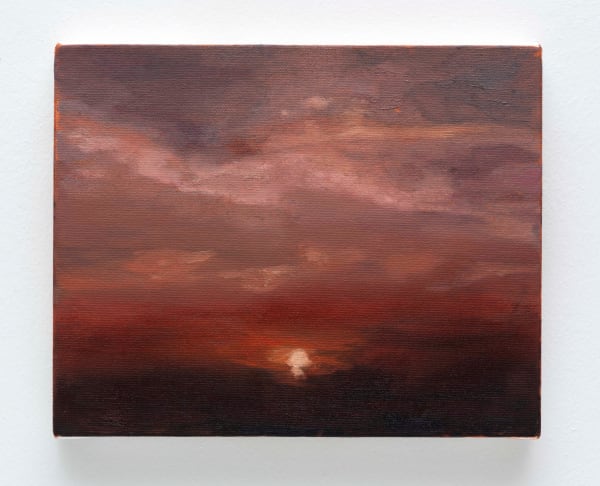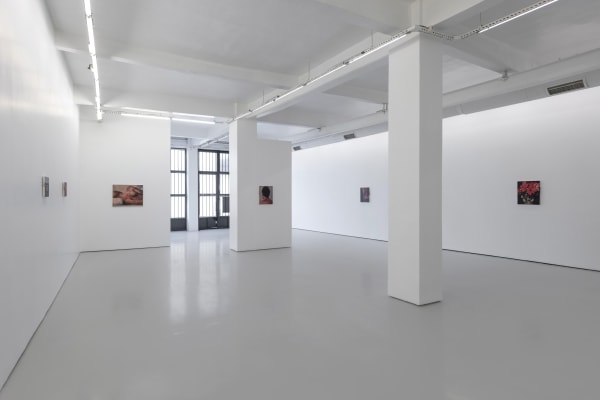Longing, sweat, roses : Berke Doğanoğlu
Past exhibition
Press release
Titled longing, sweat, roses after a fragment by the archaic Greek lyrical poet Sappho, the exhibition brings together a selection of new paintings exploring themes of absence and desire.
The greek word “eros” expresses the desire for that which is missing and sets the fundamental paradox of erotic desire between presence and absence as an underlying thread for the exhibition. Organized around a series of triangulations between small-sized paintings, the exhibition is composed of close-up views of the male body seen through fragments, framed in interior settings and focusing on the skin as revealed through strategies of concealment and the desire to grasp.
Each painting draws us into a material world made of earthy tones, subtle variations of light and fleshy textures, into the mysteries of the depicted sitter. In continuity with Doğanoğlu’s earlier work, these paintings belong to a private world, one that is slightly removed. In most cases, the figure’s eyes are obscured, their head is removed or the figure turns its back on the viewer, making them impossible to identify. The textured, disorderly brush marks match the animate quality of the flesh as well as its entropy, creating surfaces where the densities seem fleeting like a touch, in motion, always rearrangeable into another kind of order. The imprimatura technique, used by the artist for the first time in this series, replaces the conventional primer with burnt sienna – one of the first pigments to be used by humans, an anthropological constant - to unify the backgrounds of these paintings in shades of faded, dark orange. If we choose to see the background as the “main event” in these paintings, we can begin to understand the juxtaposition of genres within this exhibition as the artist’s attempt to arrive at a fusion between portrait, landscape and still life painting.
In “Touch”, the painting frames a torso half-covered by a garment while a hand reaches out to touch the skin. We do not know whether this hand belongs to the owner of the torso or to someone else, but what matters, what the painting actually depicts, is the gap between the two. Between the skin covering the flesh, and the fabric covering the skin, between the torso and the outstretched hand, everything seems to be at a standstill, suspended in dim shadows and muted sparks of ardent desire as hunger, as yet unquenched. “Antinous”, which greets the viewer, is an exception within this ensemble as it depicts the only identifiable figure here: Emperor Hadrian’s favorite lover, deified post-mortem and immortalized through countless sculptures, cities and temples in his name, turned into a symbol of homosexual love, reaching us across the centuries. Through Doğanoğlu’s depiction of his petrified face, Antinous becomes an ode to the erotic pendulum swinging between the sweetness of desire and the bitterness of absence. It also represents the triangulation of mimetic desire between a desiring subject, a desired object and the symbol, or model, that teaches us what and how to desire. In this sense, the head of Antinous, as an erotic symbol, also serves as a metaphor for painting, and especially for Doğanoğlu’s painting as it relates to desire. The textured materiality, the sensual roughness of his ambiguous surfaces on the verge of dissolution call for an empathetic and tactile relationship that invites the viewer to identify, self-recognize and project their own desires.
In her translation of Sappho’s fragments, “If Not Winter”, Anne Carson uses square brackets to give the impression of missing material whenever papyri are missing or rendered illegible. Borrowed from one such fragment, each word composing the title of this exhibition is marked with a single square bracket as “an aesthetic gesture toward the papyrological event rather than an accurate record of it”, as she notes. Brackets imply a free space of imaginal adventure, just as the space between each painting does in this ensemble brought together by Berke Doğanoğlu. In the end, these paintings convey nothing about any of the figures depicted, and everything about the nature of human desire. They are entirely captivating through the elements of concealment and fragmentation they harbor.
Berke Doğanoğlu’s paintings reflect on the material expressions and vulnerability of human desire and the human body through the intimate relationships he has formed with a world of references from literature, painting, photography and printed media. His textured, carefully and sparingly lit canvases operate through the physicality of painting, as metaphors for the human body, affect and psyche, while his compositional choices set a parallel between portraiture, still life and landscape genres. Deployed in shades of intimacy and conveying a generous offering of the self, Doganoglu’s paintings simultaneously hold a radical vulnerability and a withdrawal from meaning.
Berke Doğanoğlu (b. 1990, Tekirdağ) lives and works in Istanbul. Doğanoğlu holds a BA (2012) and a MA (2018) in Visual Arts and Visual Communication Design from Sabancı University. He completed the Post-Baccalaureate Certificate in Studio Art (Painting and Drawing) programme at the School of the Art Institute of Chicago in 2015. In 2020 he was selected to participate at the Istanbul Biennial’s Work & Research Program held by Istanbul Foundation for Arts and Culture. His first solo exhibition “As Adam, Early In The Morning” was held at THE PILL, Istanbul in 2020.He has participated in group shows including “As If It Couldn’t” 6th Year Anniversary Show, THE PILL, (Istanbul, 2022); Mamut Art Project (Istanbul, 2016).
Installation Views
Works
-
 Berke Doğanoğlu, Antinous II, 2023
Berke Doğanoğlu, Antinous II, 2023 -
 Berke Doğanoğlu, Touch, 2023
Berke Doğanoğlu, Touch, 2023 -
 Berke Doğanoğlu, Flesh, 2023
Berke Doğanoğlu, Flesh, 2023 -
 Berke Doğanoğlu, Red Gerbera II, 2023
Berke Doğanoğlu, Red Gerbera II, 2023 -
 Berke Doğanoğlu, Rest, 2023
Berke Doğanoğlu, Rest, 2023 -
 Berke Doğanoğlu, Undershirt, 2023
Berke Doğanoğlu, Undershirt, 2023 -
 Berke Doğanoğlu, Sheets, 2023
Berke Doğanoğlu, Sheets, 2023 -
 Berke Doğanoğlu, Knees, 2023
Berke Doğanoğlu, Knees, 2023 -
 Berke Doğanoğlu, Waves, 2023
Berke Doğanoğlu, Waves, 2023 -
 Berke Doğanoğlu, Sunset, 2023
Berke Doğanoğlu, Sunset, 2023 -
 Berke Doğanoğlu, Pillow, 2023
Berke Doğanoğlu, Pillow, 2023 -
 Berke Doğanoğlu, Hair, 2023
Berke Doğanoğlu, Hair, 2023
Press






















